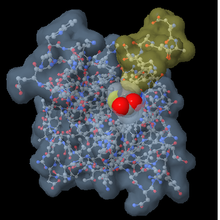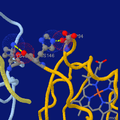Jmol
 | |
 Jmol, a Java molecular viewer for three-dimensional chemical structures | |
| Developer(s) | Jmol development team |
|---|---|
| Repository | |
| Written in | Java |
| Available in | Catalan, Chinese, Czech, Danish, Dutch, English, French, German, Hungarian, Indonesian, Italian, Korean, Portuguese, Spanish, Turkish, Ukrainian[1] |
| Type | Molecular modelling |
| License | LGPL |
| Website | jmol |
Jmol is an open-source Java tool for molecular modelling chemical structures in 3D.[2] Jmol returns a 3D representation of a molecule that may be used as a teaching tool,[3] or for research e.g. in chemistry and biochemistry. It is free and open source software, written in Java and so it runs on Windows, Mac OS X, Linux and Unix systems. There is a standalone application and a development tool kit that can be integrated into other Java applications, such as Bioclipse and Taverna.
A popular feature is an applet that can be integrated into web pages to display molecules in a variety of ways. For example, molecules can be displayed as "ball and stick" models, "space filling" models, "ribbon" models, etc.[4] Jmol supports a wide range of molecular file formats, including Protein Data Bank (pdb), Crystallographic Information File (cif), MDL Molfile (mol), and Chemical Markup Language (CML).[5] There is also a JavaScript-only (HTML5) version, JSmol, that can be used on systems that do not have Java.[6]
The Jmol applet, among other capabilities, offers an alternative to the Chime plugin,[3] which is no longer under active development. While Jmol has many features that are not available in Chime, it does not claim to reproduce all Chime functionality (most notably, Chime's Sculpt mode). Chime requires plug-in installation and Internet Explorer 6.0 or Firefox 2.0 on Microsoft Windows, or Netscape Communicator 4.8 on the Mac OS 9. Jmol requires Java installation and operates on a wide variety of platforms. For example, Jmol is fully functional in Mozilla Firefox, Internet Explorer, Opera, Google Chrome and Safari.
Screenshots
-
Crystal structure of an H/ACA box RNP from Pyrococcus furiosus.
-
Highlighting two salt bridges in hemoglobin tetramer (hemo group as sticks at bottom-right).
-
A fragment of transcription factor TFIIIA forming three consecutive zinc finger motifs, bound to a stretch of DNA.
-
Eubacterial 70S Ribosome from Thermus thermophilus.
See also
- List of molecular graphics systems
- List of software for molecular mechanics modeling
- Chemistry Development Kit (CDK)
- Molecule editor
- Molecular graphics
- Proteopedia
- PyMOL
- SAMSON
- Jmol extension for MediaWiki
References
- ^ Jmol translations
- ^ Chen, Jim X. (2008), Springer (ed.), Guide to Graphics Software Tools, p. 471, ISBN 978-1-84800-900-4
- ^ a b Herráez, A (2006), "Biomolecules in the Computer: Jmol to the Rescue", Biochemistry and Molecular Biology Education, 34 (4): 7, doi:10.1002/bmb.2006.494034042644
- ^ Herráez, A (2007), Lulu (ed.), How to Use Jmol to Study and Present Molecular Structures, Volume 1, p. 21, ISBN 978-1-84799-259-8
- ^ Willighagen, E (2001), "Processing CML conventions in Java" (PDF), Internet Journal of Chemistry, 4 (4): 1–9
- ^ "JSmol". Retrieved 2015-11-02.
External links
- Official website
- Willighagen, Egon; Howard, Miguel (June 2007). "Fast and Scriptable Molecular Graphics in Web Browsers without Java3D". doi:10.1038/npre.2007.50.1.




